I specifically tried not to work for the three weeks I was traveling for my honeymoon. But of course being a bike blogger has poisoned my brain, and I couldn’t help noting city-making lessons for Seattle. So here’s a brief rundown of where I went and what I saw.
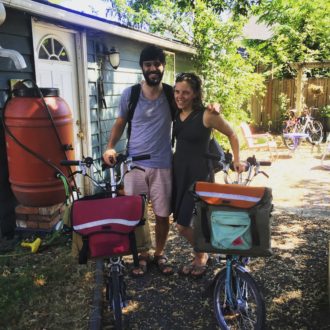
First step in our trip was to pack up our Gilman Bags by (SBB advertiser) Swift Industries and load them onto our Brompton folding bikes we bought from (SBB advertiser) G&O Family Cyclery. These proved to be dependable and versatile multimodal travel machines.
Bringing the bikes through Seatac Airport was a breeze. We checked the saddles in our bags and carried the bikes through security (they fit though the scanners if the saddles are removed). Iceland Air checked them at the gate like a stroller, saving them the tumbling trip through the guts of the baggage system and, importantly, saving us the need to buy and lug along big bike cases. However, the Iceland (Keflavík), Amsterdam and Paris (Orly) airports were less friendly to the bikes than Seatac (we escaped with only one mangled fender, so it could have been worse). We’ll probably explore a box solution of some kind next time.
Kelli and I first flew to Iceland, which is a tremendously beautiful place. Reykjavik is a very cool city, and we had a great time soaking in the Blue Lagoon and hiking through the lava flats. A summer bike tour there seems like an amazing adventure. Added that to the to-do list.
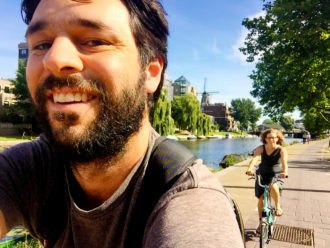 We then headed to Amsterdam, which is just an incredible city. A dense, major city with essentially no subway, the whole city shares the same surface streets. It’s a kind of chaos with people walking, biking, motorbiking, driving and riding the frequent trams all at the same time. And it works because everyone (well, except people driving, who are often stuck waiting) are moving at a consistent, safe speed.
We then headed to Amsterdam, which is just an incredible city. A dense, major city with essentially no subway, the whole city shares the same surface streets. It’s a kind of chaos with people walking, biking, motorbiking, driving and riding the frequent trams all at the same time. And it works because everyone (well, except people driving, who are often stuck waiting) are moving at a consistent, safe speed.
Ten miles per hour is actually very fast if you don’t need to stop all the time. And if people are driving and biking slowly enough, traffic signals often just aren’t needed. This really helped support my concerns that Seattle’s use of traffic signals to help road safety is looking at the problem all wrong. If a person can’t cross a street without a signal, the street itself is the problem.
Amsterdam is bike-friendly almost despite the bike lanes, which are packed to the brim with people on bicycles and motos (it took a little adjusting to get used to motorbikes in the bike lanes). We quickly learned that the best streets for biking comfortably are the ones without bike lanes, since those streets are lower traffic and typically more scenic. Many of the canal-adjacent streets switch their one-way directions often to prevent cut-through traffic, but people can bike in both directions. This is a very easy and cheap way to create people-focused streets while still allowing car access.
There are so many streets in Seattle that could use this strategy. Most neighborhood greenways need some kind of traffic diversion, for example, and this could be a very cheap way to do it. This could also be a great way to lower the cut-through traffic on key scenic streets like Lake Washington Boulevard or select streets in the dense neighborhoods like Bell Street.
We then took a train to Groningen, a wonderful, compact city filled with art (the Groninger Museum is one of the best museums I’ve ever been to). The city was also a great launching pad for a bike adventure. We headed first to the North Sea and stayed a night in little Vierhuizen before biking across Friesland to Leeuwarden, where we caught a train to Brussels.
Biking across the Netherlands is no sweat, and most of the other people biking outside the cities were of retirement age. We biked halfway across the country either on separate bike paths or low-traffic streets. Every bridge was bike-friendly. It was almost too easy.
For an idea of what bike travel is like in the Netherlands, consider that this is what bicycle wayfinding signage is like even in the middle of vast farmland with no other human beings in sight:
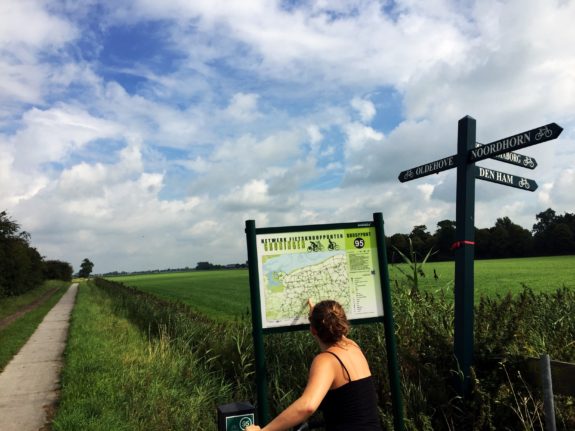 Brussels was really just a quick stopover to break up a long train day, but we were surprised to find that the city closes many central streets to cars nightly. Busy streets were often marked with feeble sharrows and, for the first time on our trip, some people were wearing helmets. In other words, it felt like home.
Brussels was really just a quick stopover to break up a long train day, but we were surprised to find that the city closes many central streets to cars nightly. Busy streets were often marked with feeble sharrows and, for the first time on our trip, some people were wearing helmets. In other words, it felt like home.
But the city also had some great small streets that were either car-free or too skinny and winding to attract lots of car traffic. This was especially true in our next stop: Lyon, France.
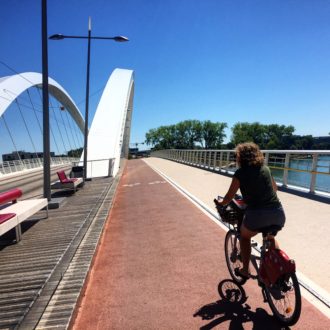
I fell in love with Lyon, where the long-established bike share system Vélo’v is a regular part of daily life. And a great many of those trips are up and down the city’s packed car-free or car-light streets right in the heart of the city center. As Seattle considers the role of car-free streets in our city — especially on Capitol Hill — efforts by cities like Brussels and Lyon could be a good guiding light.
Car-free streets are great for nightlife, sure, but they are also great during the daytime (deliveries are still allowed, or at least tolerated). And when they are long and continuous, they make great bike routes, too. Imagine a car-free Pike or Pine Street from downtown to Madison…
Our trip then took us to Paris, which is of course an amazing city. But wow, that city has a serious car problem.
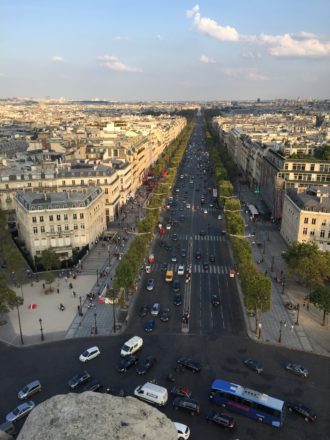
It’s Paris. It’s beautiful and packed with history and art and culture and everything that comes with being a global center. But it is also packed with cars and streets so wide it takes slower-moving people two signal cycles to cross (if you zoom you can see the skinny median in the photo is packed with about 30 people).
Don’t get me wrong, I loved Paris for all kinds of other reasons. But for the issues we talk about on this blog, I was surprised the city is not more of a leader in European safe streets efforts. We biked a little bit using the ever-present Velib bike share system, but it was pretty stressful vehicular cycling each time we did it (except for some of the lovely riverside bike routes and the rare protected bike lane). So we mostly stuck to walking and the Metro. We were on vacation, after all.
Thanks for reading, everyone! This trip was a great reset for me. I feel reinvigorated and ready to continue pushing our city to experiment with our public spaces, with our land use choices (that was a huge lesson from every city on this trip: Seattle needs way more small business spaces!) and to take bold action of safe streets and connected bike routes.
Seattle is a stunning and special city, and we have the opportunity to be a true global leader in making the city of the future. Some of that means taking lessons from old cities in Europe, but some of the means forging a genuinely new path (like being a fully accessible city for people with various mobility challenges, something most places we went in Europe failed spectacularly to achieve).
We have a lot of work to do, but so long as we can push past people’s predictable resistance to change (a problem in Europe, too) Seattle can become one of the great cities of the world. It can happen fairly quickly if we let it.








Comments
30 responses to “What I did on my summer vacation”
Paris maybe getting better:
https://www.fastcoexist.com/3058685/paris-is-redesigning-its-major-intersections-for-pedestrians-not-cars
Tom, did you observe any areas where cyclists mixed with streetcar tracks? My most recent location was Prague, which is literally criss-crossed with tracks. I did not bike there and, later, tried to find some info on how cyclists deal with it but did not find any significant articles.
Many major cities in The Netherlands (including Amsterdam) have streetcar tracks and heavy bicycle usage. They get along safely. The ability to safely co-exist is mostly a function of careful design, construction, and education. It probably helps that many of the road planners, engineers, and contractors no doubt bike to work.
Mark – Do you have any design specifics? When I was in Prague, I did not see any accommodations for cyclists. In some parts, the tram had a dedicated right-of-way. In others, it was similar to Westlake. But I didn’t see many cyclists, either. Quite different from Amsterdam.
I have ridden in the Netherlands in places where bikes mix with street car tracks, and the first time we met them it Freaked Me Out because I’ve heard all the horror stories in Seattle. Then I rode over them and it was no big deal. They do it all the time, and they don’t even worry about riding over them carefully.
The place in The Hague I’m thinking of isn’t on streetview, but here’s a place with a mess of streetcar tracks and bike lanes. In other places I watched people cycle between the tracks, and saw places where the bike lane crossed at a very shallow angle. Seriously, it really doesn’t seem like a big deal there.
https://www.google.com/maps/@52.0802433,4.3101293,3a,75y,263.36h,73.03t/data=!3m6!1e1!3m4!1sNpc7N0XMI72Jej39Jqahfg!2e0!7i13312!8i6656!6m1!1e1
Michelle – Well, something must be different. Wider tires?
Peri, that’s my guess too: wider tires.
Tire diameter definitely makes a difference but it would also be good to understand what, if any are the riding differences of cyclists in the Netherlands versus here in Seattle. The wider tires are typically because they are riding upright ‘city bikes’ which use wider tires as a default and are conducive to a different style of cycling which is more leisurely in general. If most cyclists here rode Pronto bikes there would be a difference in pace and ‘style’ of riding because the bicycle itself necessitates a different style of riding.
Tom, it sounds like a time well spent, I’m glad you had such an enjoyable vacation.
None of the bike lanes in that StreetView are crossing tracks there at angles that would routinely cause problems for someone with skinny tires unless they didn’t see them and steered in an unusual way.
Differences other than tire width might be interesting. Apart from angle and tire width, a wheel is more likely to get grabbed by the tracks if it’s weighted heavily. By angle your front wheel is more likely to get grabbed because it can be steered off-center… but on a more upright/relaxed bike your front wheel is much more lightly weighted, so maybe an upright riding position saves you from getting your front wheel grabbed. Front-wheel grabs are the ones that are really hard to recover from…
The Dutch are highly trained and experienced cyclists. (Watch a Dutch couple where one of the pair is riding on the back rack stop and start some time if you don’t believe me.)
Yet, in spite of that, people apparently die on the tracks in Amsterdam, too:
http://archtrauma.com/?page=article&article_id=23083
but at least in Amsterdam the streetcars are an essential (though outdated) part of the infrastructure. Here they’re just shiny new gimme’s from the city administration to developers that serve no real transportation purpose.
@Greg,
According to the study you cited, the Dutch also have a 25% commute modal share by bicycle, before even looking at their overall transportation modal share. With all of that, this one year study cited one death attributed to rail tracks in the roadway. One is still too many but the point I was trying to make in my earlier post was that the riding style and type of bike are both different and safer than Seattle and by what I see in the number of fatalities relative to commute modal share that seems to be true. Don’t forget to add to this their foolhardy proclivity to ride without helmets!
I’m not going to take a deep dive into absolute numbers of cyclists and numbers of cyclists injured, but if someone else wants to, it would be interesting to see.
Congratulations, it sounds like a wonderful trip.
I agree that a steady 10 miles per hour isn’t a bad pace for city biking. Not having a lot of stops and lengthy stops is important, but I’d also add that direct routes are critical to make time. NE Seattle to SLU via the Burke-Gilman and Westlake is noticeably longer vs Roosevelt/Eastlake for my commute.
When you mention preventing cut-through by alternating the direction of one-way streets, I’m thinking of 98th between Northgate and Lake City Way. It’s actually two-way for cars the whole way, but there’s a similar effect from two “do-not-enter” signs along the way. Unfortunately they lack “except bikes” and it’s a pretty hilly route. But again, the direct route has advantages over alternate routes (115th or 125th).
It’s a good easy inexpensive technique.
On a street make each block alternating one way for motor vehicles, two way for bikes. Put diverters on the ends and voila! Low motor traffic and a great bike route but locals can still drive home and get deliveries and even park on the street.
Vancouver is starting to do that in some of the newer greenways like York and Comox.
I was recently in Paris and I was quite impressed by the bike infrastructure and I wonder how widely you travelled through the city. They are well on the way to a network of bike friendly streets where they have taken parking away from one side and added a two way bike lane that is elevated at sidewalk height or separated from vehicles by a physical barrier. Bikes have their own lights at intersections. They do not put bikes lanes in parking door zones. In many side streets that are one way for cars, bikes have a lane to ride against the traffic flow which works well. The whole system is very well designed for commuters who are happy moving at 10-12 mph. Hardcore cyclists who want to be at 20 mph tend to be out in the traffic lanes.
Mostly I was in the city center and in the Belleville/Pere-Lachaise area (and in between). It’s a big place, so I could have missed the areas that were better. There were sections that worked well, but as someone on vacation it didn’t seem worth the stress to bike. I’m sure living there you learn the best routes and make it work.
Did you carry pamniers on your Bromptons?
Nope, just the Gilman bag in the front and a backpack.
I have a visit to Copenhagen planned for next year, and definitely would like to explore the city by bike. I have never been in a city where everyone bikes and can’t wait to try it out.
As it happens, I am also flying IcelandAir (changing planes in Reykjavik) and I do have a folding bike I could potentially bring. How much did you have to pay to take your bike on the plane, and what made you decide to do that vs. rent bikes after you arrive?
Also, did you wear helmets in the cities where nobody else wears helmets?
If we were just going to one place we would have just rented. We brought our folding bikes with plans to do some non-round-trip touring.
Do you think most airlines will let you check your Brompton at the gate? I have always checked mine before security.
Thanks for your trip recap Tom, and bringing back lessons Seattle could learn from.
Here’s a link to one of our early meet up videos — What Seattle can learn from Dutch street design? https://www.youtube.com/watch?v=l0GA901oGe4&list=PL7eTI0Cpt8zCzojVnM_pQYXac8-SRxSDE
I see you in the audience. You may want to watch again now that you’ve experienced the real thing.
I fly often with my Brompton, both in the US and internationally (Europe, Australia). The secret is to treat the Brompton as a carry-on. I walk the bike through the airport, folding it to go through the security scanners. It fits in the overhead of a full-sized airliner (not regionals… for those I use a hard case and check it). I carry a folding pump with gauge, but will often stop at a local bike shop and use their floor pump. I have a patch kit and folding drivers, hut run Schwalbe Marathons and haven’t had a flat yet. I travel with an Orca rolling carry-on, with shoulder straps and with a suitcase-detachable backpack for my laptop and electronics/camera. Because the carryon and backpack are seen as one bag, I meet the two carry-on limit.
Regarding bicycle friendly accommodations, places like Amsterdam have figured it out, using separate lanes for different classes/speeds on transportation. Disparities in speed create risk. Here in Washington, we need to stop disparaging transportation choices and acknowledge that cars/drivers aren’t pariahs and need to be supported. Instead of making things worse for cars, make them better for cyclists AND drivers. Separate lanes is the way. People ride bikes in Copenhagen, Amsterdam, and increasingly in London not because these cities have intentionally made driving more onerous but instead because cycling has been made safer and more comfortable. The $60B that is proposed for expanding light rail will not do this. We need to tailor light rail to augment the existing commuting roadways (405), at a much lower cost, and use some of the savings to improve cycling AND driving infrastructure.
1. Absolute speed creates risk, too!
2. Drivers aren’t pariahs but supporting them at today’s numbers is…
2a. … going to make the project of creating separate bike lanes pretty tough, when most of the reasonable places to create them are along today’s road ROWs.
2b. … going to make the project of creating walkable places a lot more difficult.
2c. … going to be tough for environmental sustainability.
3. The “existing commuting roadways”…
3a. … are not within an easy walk of today’s destinations, particularly 405, which aggregates north-south traffic demand across a very wide part of the eastside.
3b. … are poorly suited to new transit-oriented development, particularly in the suburbs, where interchanges are extremely large with very poor walking conditions.
3c. … are often in ROWs already built up wall-to-wall with lanes of traffic, so not as cheap to augment as we’d hope.
3d. … still represent a lot of ST’s existing service, plans and proposals. They’re proposing BRT up and down 405, for example, and nobody is projecting the buses will struggle to handle the passenger volumes attracted in that corridor.
Don’t Copenhagen, Amsterdam and London have kind of nice rail options in addition to their bike networks?
Brommies!!
I bought my first folder (1st of 5) in 2000 and soon concluded they’re a useful tool for planning the intersect between bicycling and pedestrian infrastructure. Their slow speed poses less an imposition to walking where riding in traffic is insufferable. They’re more easily accommodated on light rail and inside buses when the front rack space is taken. Central Seattle needs better buses and a better bus system to actually reduce miserable traffic enough for other modes of travel. I trust neither Metro nor Sound Transit to make it happen. I do not support ST3. Sigh.
I call the Ice Cube in Occidental Park “nihilism” in the same vein as Sculpture Park oddities; “Wave” is a giant earth scraping plow, Metal Tree a remnant, Eagle a shipping Crane, Man & Boy is oh never mind, you get the idea… city fathers, more misanthropic than benevolent, can’t resist immortalizing their true nature of capitalist market manipulators brainwashing a sterilized class of millennial nitwits, and above all, upholding the automobile as a central cornerstone of corporate control. Don’t kid yourselves. Warren Buffett doesn’t care. Wannabe governor Bill Bryant has a ‘deplorable’ record. And Bill Gates is just another guy with more money than he knows what to do with except to make more money.
Hey, now, just because you disagree with millenials about the timing of various prophesies no reason to call them “nitwits”!
Sorry. I’m just afraid that the current generation of 20-something ‘millenials’ are too easily misled to believe technology established by their own and older generations doesn’t have a dreadful downside. We could learn how to plan and build transportation systems without globe-trotting. We could build our own communities to become fine examples of urban living, but that wouldn’t sell Boeing ticket getaways far from the ‘deplorable’ culture of car dependency. I’m reminded of Jimmy Neutron’s “advanced alien civilization” that devolved into amebic blobs so they could live 24/7 inside their ‘mobility devices’.
[…] What I did on my summer vacation […]